Forget about Michigan and Motor city. "Ford is a Cork company; it just has a very large American branch to it." That's how one former worker at the firm's Cork plant sums up local sentiment towards the blue oval brand. It's a common refrain in a city proud of its links to the car giant, this year marking its centenary in Ireland.
Ford's story is an emigrant’s tale, a family escaping the famine, a son’s return to the land of his father hoping it can share in his success.
Admittedly it's hard to consider hard-nosed Henry Ford as a sentimentalist. The industrialist was the persona of utilitarianism, an innovator who revolutionised modern manufacturing, brought motoring to the masses and ruled the automotive world with an iron fist.
Yet for decades the trundle of an assembly line in Cork showed he never forgot his family’s roots.
Family ties
Travelling on the N71 in west Cork you come across a shiny silver Model T Ford in the centre of Ballinascarthy. This is the land of the Fords, farmed by the family for more than 300 years.
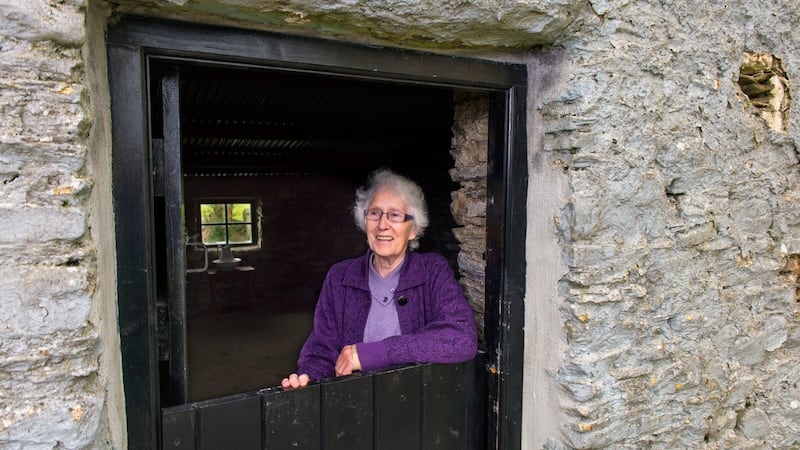
Then, from a family of five sons, four left for Michigan in the 1800s. Hazel Buttimer Ford is directly descended from the one son who stayed behind. "We were the part of the family that remained in the famine years at Crohane outside Ballinascarthy. All Henry's line, they all went away to America."
The first Fords to emigrate to the US settled in what is now Dearborn, Michigan, in 1832. This was frontier territory. Henry's grandfather, John, decided to join them in 1847, having been evicted from his tenant farm during the famine.
The family, including his 21-year-old son William, bought their first land near Dearborn in January 1848. William went on to marry Mary Litogot Ahern. Of Dutch extraction, she had been orphaned when her father fell off a roof and was adopted by Patrick and Margaret Ahern.
Henry Ford was born on July 30th, 1863. At the time William and Mary were living with the Aherns and when Henry was 13 Mary died; it was under the guidance of the Aherns that Henry was raised.
Patrick Ahern was from Fair Lane (now Wolfe Tone St) in Cork, a site visited by Henry Ford and his family during their first trip to the city in 1912.
It was during this trip that he is believed to have identified the potential site for his first purpose-built Ford entity outside of North America. It was also during this visit that he demonstrated his sentimentality for family ties didn't come at any price.
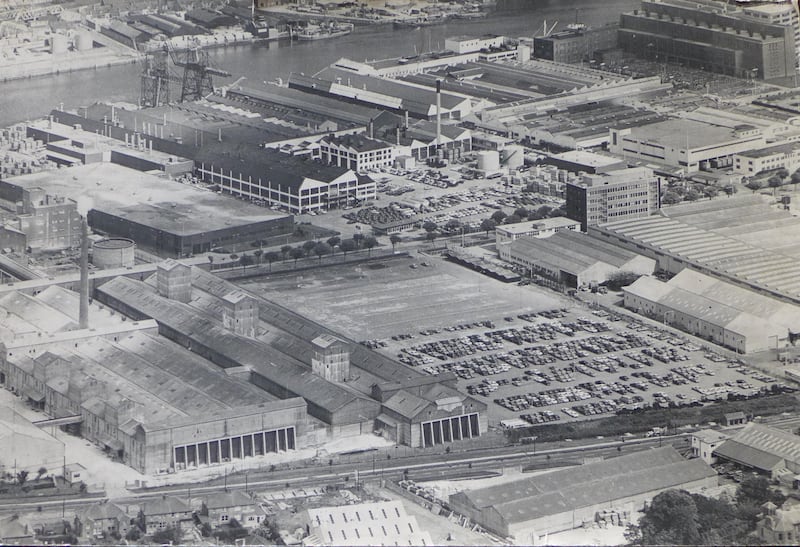
According to Betty Hennessy of the Ballinascarthy Festival Committee, Henry Ford made an effort to buy the land his grandfather farmed but the owners, three single brothers, wouldn't sell, aware he was a well-heeled Yank. "The parish priests advised them to hold on because there was more in him," she says. They chose to barter with the wrong American. It seems you can put a price on sentiment, and in this case, it was one Henry Ford wasn't willing to pay. He walked away from the deal without making a second offer.
Back in Cork city, the purchase of the land for the factory was completed in 1917 and work began within weeks of the deal being agreed. Tractor production began at Marina in 1919, while in 1923 assembly began of the legendary Model T.
Mass production
This was at a time when Henry Ford, in his 50s, was driving an industrial revolution. Introducing mass assembly to the factory floor in 1913 heralded a new era of mass production manufacturing.
A year later he was causing consternation among rival business leaders by offering $5 a day for an eight-hour shift, pay levels unheard of in industry at the time. In return for the high wages, Ford got to increase the pace of the line and the choice of the best of the employees around. He later described the wage hike as the best cost-cutting move he ever made.
When it came to business he seemed to have the Midas touch. Yet this shrewd industrialist seemed prepared to let sentiment influence his decisions on Cork.
A business case can be made for the Cork plant. Labour costs in Ireland were substantially cheaper than Britain, where Ford had also experienced labour disputes at its Manchester assembly plant in 1912. There was also intense demand for vehicles, particularly tractors, as the first World War was raging and the British government sought machinery that would free up labourers.
Yet Ford had already established major sales markets in Canada and Latin America, both regions imposing hefty import tariffs and so these markets would have benefitted greatly from production plants. What's more, whatever industrialisation there was in Ireland was largely based on the east coast, in Belfast or Dublin, not Cork.
In any event, by the time the first tractor came off the line at the Fordson plant in Cork on July 3rd, 1919, the Great War was over, but another fight was brewing at the factory gate.
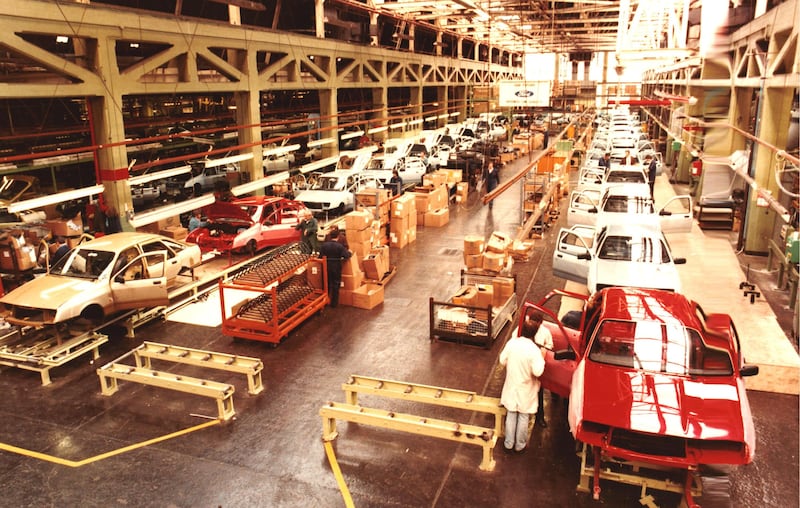
While the War of Independence and the subsequent Civil War certainly drew in workers from the plant, as historian Miriam Nyhan writes in her book Are you still below?, the necessity of holding down a job with one of the best-paid employers in the city would, by and large, quell any overly active political policies or activities within the factory itself.
So, in spite of the surrounding turmoil, production of tractors at Marina continued and by August 1921 the foundry was supplying parts to the Manchester assembly operation as well. About 1,000 people were employed at the plant at this time. By the late 1920s employee numbers had risen to 7,000 as the Marina plant became Ford’s only tractor facility in the world, while also producing the new Model A and AF. Exports from Cork went all round the world.
Life on the line
Barry Kearney began work at the Marina plant in January 1962, after working as a motor mechanic. “I was earning £7 10 shillings at the time for a 5½-day week at a local garage. Six weeks after I went into Marina, my wages shot up to just over £11 a week for a five-day week.
The pace of the line wasn't too tough. If every man did his job, it was okay. You couldn't slack but beads of perspiration weren't dropping off your forehead
“The pace of the line wasn’t too tough. If every man did his job, it was okay. You couldn’t slack but beads of perspiration weren’t dropping off your forehead. You were kept going from 8am to 4.30pm but you weren’t coming out exhausted or on your hands and knees. And you were paid well.”
The relatively high pay was in line with Henry Ford’s policy in the US, but it also reflected Ford’s hatred of unions.
John Brennan started life on the Cork assembly line in the pre-union days. "It was run exactly like the massive Ford factory in Dearborn, Michigan during the 1930s. Just like in Michigan, Ford ran a tight ship where there was no freedom to wander off or socialise. As in the US, Ford Cork had uniformed men patrolling the factory to enforce no-smoking and other rules. There were also snitches who curried favour by reporting on others. You learned quickly to keep your mouth shut."
As Nyhan outlines in her book: “Trade unions didn’t enter the plant until 1941, but even then it should be noted that pay rates in Ford were always higher than those of other commercial concerns in the locality. This situation, combined with employment shortages in Ireland for protracted periods during the plant’s existence, made the Marina a competitive place to get into.”
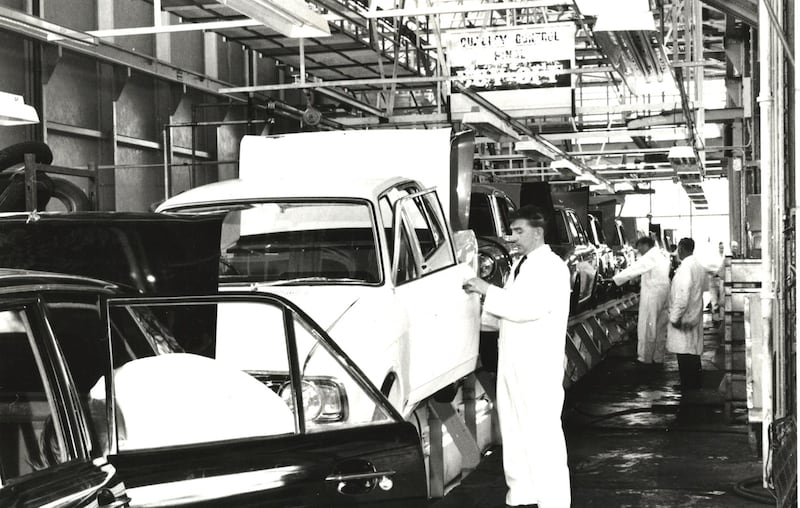
As to politics in the plant, Denis McSweeney says: “There were people involved with political parties. And later we did have the national background at the time, manifested in a payroll heist on the premises by the Provisional IRA with unquestionable connections to the inside.”
Religion at the plant
While efforts were made to keep politics at the factory gate, religion made it into the heart of the plant. Barry Kearney recalls that on his first day at Ford, when lunch was over, he took a short-cut through the factory. “As I came through the line, I came across 70 or 80 men on their bended knees saying the rosary. The rosary was recited every day voluntarily at 1.15pm. In preparation for the Marian year of 1954, the workers collected money and bought a statue of the Virgin Mary and built a large glass case for it. The whole thing was mounted in the centre of the factory.”
When production demand fell in Cork, management turned to their larger sister plant in Dagenham, England to help out the Irish staff. There was a steady flow of Irish workers to and from the UK assembly line.
"One of the fascinating things was that the weekly pay rates in Dagenham plant were published in the Cork Evening Echo," says McSweeney. "It meant a guy here could see what he could get in Britain and make the move. I'm sure a lot of the revenue of the MV Innisfallen that sailed from Cork to Fishguard was derived from guys going to and fro with Ford. Publishing them also meant that many a 'grass widow' living here wanted to know what their husbands were really making over there. It shows how tightly the two locations were married to each other."
Those who went to England returned during the summer in their sharp suits with a cosmopolitan swagger. It led to them being dubbed the “Dagenham Yanks”.
And it wasn’t just workers that the ships from Dagenham provided.
William Cuddy is honorary secretary of the Irish Model T Ford Club and has been restoring the 'Tin Lizzies' since 2000. He recalls how as the plant moved from full production to assembly, from the 1950s to the 1980s, cars arrived in Cork in crates from the Ford plant in Dagenham as so-called Knocked-Down (KD) kits. The crates, some as large as 16 feet by five feet, were made of water-resistant marine plywood. As Cuddy recalls: "My first memory of them was on the quayside; boxes stacked as high as possible."
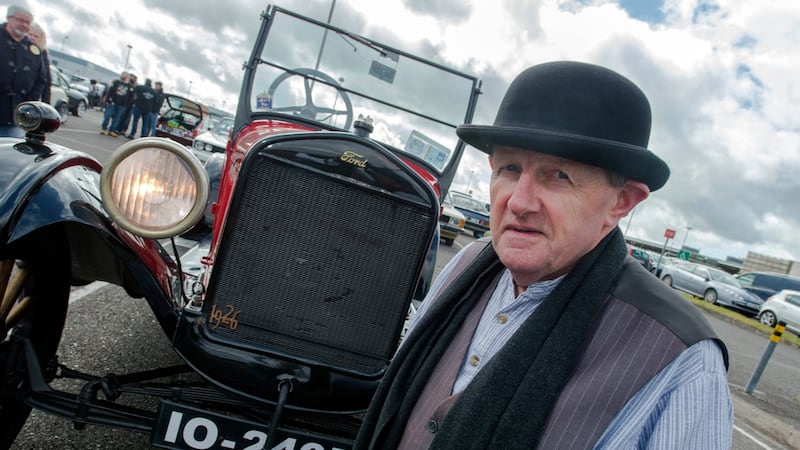
These went on to be converted into everything from garden sheds to kennels, chicken coops to temporary stages. "There were particularly popular as material for summer houses in places like Crosshaven, Roberts Cove and Fountainstown. Some are still there to this day," he says.
Closure
Denis McSweeney describes the Ford Marina plant as the pride of Cork. “I still remember the Blue and White and clearly feeling this is a Cork company. Anyone down there, getting better money than most, you began to get that pride and your chest stuck out a little broader thanks to your link to Ford.”
Yet for all that local pride, the reality was that by the 1980s the Cork plant was believed to be losing about €10 million a year.
As Andrew Hamilton wrote in The Irish Times in October 1983: "It doesn't call for much logic to realise that an Irish car-assembly industry makes no economic sense. It was anyway a hangover from the 1930s when Eamon de Valera was preaching virtuous self-sufficiency. Motor assembly was nothing more than an expensive job-creation programme and the customers who were the motorists of Ireland paid for it. A crate of parts for local assembly usually cost as much to ship into Ireland as a complete car landed fully built up."
Ireland's entry to the EEC also meant the protectionist tariffs that supported car assembly in Ireland were due to end from January 1st, 1985. By 1983 rivals were already ending assembly operations here. Datsun and Toyota followed Talbot and Fiat in closing assembly lines here, leaving Ford the only major car-assembly operation on the island.
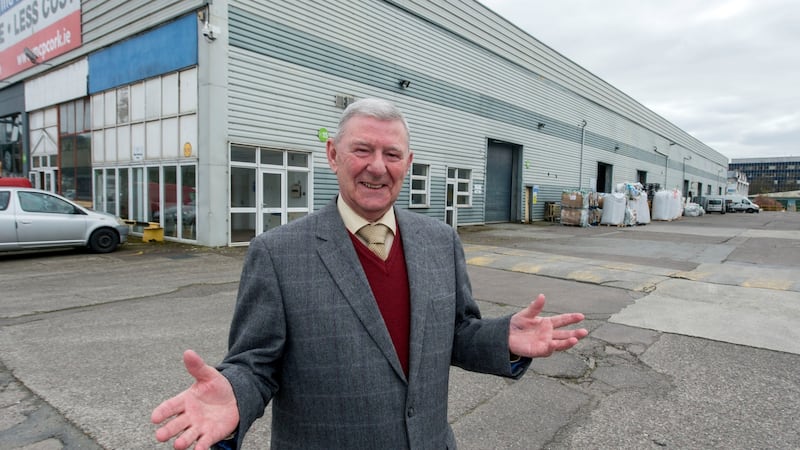
Attempts to save the plant came to nothing. McSweeney says: "They were never going to be able to save the assembly as the scale of the plant was just too small. That would never be viable in the new environment. The Genk plant was producing 1,350 cars a day at the time and we were producing 80."
"The writing was on the wall but, like everything else, you hope that it didn't come
According to Barry Kearney: “The writing was on the wall but, like everything else, you hope that it didn’t come. I think the other thing that coloured everyone’s view was that Henry himself had roots in Cork and it was hoped there might be a bit of sentiment perhaps.”
Yet in Dearborn, any sentimentality for Henry’s Cork roots had long since waned. “I would say there was a lot of ignorance about the Cork links, even as to the origins of Henry Ford. The Cork angle would not have pervaded the consciousness of many people in the organisation at management level,” says McSweeney.
Alternative investments
"The Cork management made a lot of efforts to find alternative investments and there was a component item suggested at one stage and a site identified down in Carrigtwohill. I think at the time in the mid-1980s you were dealing with in-again-out-again governments and their principle distraction was how to stay in office and they weren't focused on this major headache that was coming up and they didn't put enough effort behind the project. We just ran out of road on the plan. The company focus moved on from it."
<a class="search" href='javascript:window.parent.actionEventData({$contentId:"7.1213540", $action:"view", $target:"work"})' polopoly:contentid="7.1213540" polopoly:searchtag="tag_person">Bill Ford</a> has become extraordinarily attuned to what has happened with the Irish economy over the past few years and maybe he could be persuaded to look to Ireland for future investment."
A century ago Henry Ford brought forth a motoring revolution with his Model T, offering affordable motoring to the masses. Today we are on the cusp of another revolution as we move towards electrically powered self-driving vehicles. In the face of this disruption Ford now refers to itself as a tech firm. The firm’s executive chairman – and Henry’s great grandson – Bill Ford’s last trip to Ireland coincided with a visit to the 2015 Web Summit.
According to Denis McSweeney: "Bill Ford has become extraordinarily attuned to what has happened with the Irish economy over the past few years and maybe he could be persuaded to look to Ireland for future investment."
In Ballinascarthy, Hazel Buttimer Ford says transatlantic family ties are now stronger than they have ever been. There are more regular visits and the Michigan clan are now well versed in their Cork roots. Perhaps there’s a chance for Ireland to play a role in the next wave of Ford’s automotive revolution.
As Henry demonstrated, there is room for sentiment, provided the price is right.
My memories
Dennis Sweeney: ‘Ford shaped me, educated me, directed me and moulded me as a business man’
“From our lofty perch above the city, we had a view down the river to the Marina, where we could see the white walls and black roof of the industrial giant stretched along the banks of the Lee.
"Ford men lived around us at home. A job on the Marina with Ford, or at the neighbouring Dunlop plant, meant financial security in relative terms, at a time when employment in the city was, for the most part, casual.
“My mother could scarcely conceal her joy when I was given a job at Ford as, to her mind, I was made for life.
I couldn't, or so it appeared to me as a single man at the time, spend the money that was coming in so fast as salary.
“In a way she was right for I worked there for the rest of my working life. Ford shaped me, educated me, directed me and moulded me as a business man.
“My overriding impression of the Marina on that first day, October 4th 1971, was of bustle, activity, huge numbers of men and material on the move with a purpose, the noise, but, above all, the inexorable grind of the production line. There was only one rule: don’t stop the line.
“It was like a small town, eight acres under roof; behind the guarded gates, it appeared self-sufficient. It had its own 300 metres of wharf, its own cranes to load or unload ships, its own workshops for fitters, electricians or millwrights. In the ‘cut and sew’ 25 tailors made the seat covers and upholstery. At the time, the Marina produced Escort, Escort Van, Cortina, Transit van and D-Series trucks at the rate of 80 units a day.
Slagging and a tireless sequence of practical jokes were features of life there.
“I started as a security man, doing the humdrum work that implies. I worked security shifts for eight months. The plant was racing to meet demand, working an extra hour per shift. I couldn’t, or so it appeared to me as a single man at the time, spend the money that was coming in so fast as salary.
“I was promoted to the sales department after eight months. However, the plant reflected the pulse of the company’s daily life, and we were joined to it at the hip. Everybody at the Marina was involved in feeding the line or in shipping and selling its produce.
“Slagging and a tireless sequence of practical jokes were features of life there. A very strong bond exists between those who have ever worked at the Marina. Even after retirement, resignation or, unfortunately, redundancy, Ford men always inquired how things were going in the firm. The ubiquitous greeting, particularly for those of us who still worked for Ford after the plant closed, was “Are you still below?” And for many happy years I still worked below.
Denis McSweeney retired from Ford Ireland as director of marketing in May 2010.



















